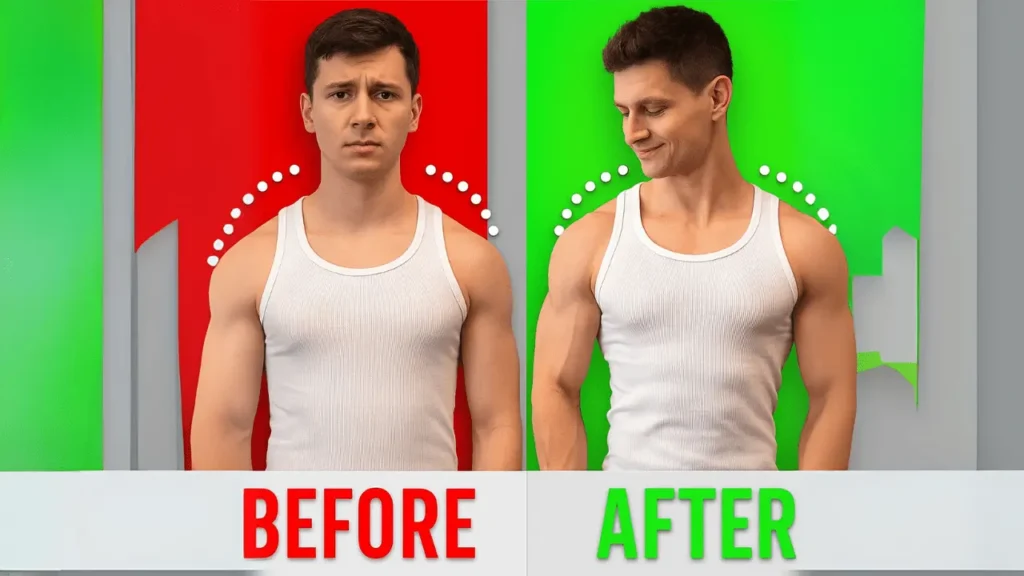3 Shoulder Exercises That Transformed My Physique

The problem of narrow shoulders is quite common nowadays. As most of the people use their phone just by sitting in the crouched position, it may result in a narrow shoulders problem, and genetics indeed play a role in this factor. But with the right scientific approach, we can absolutely fix this problem. Even though I myself have narrower shoulders, I found these exercises. After a few weeks I saw insane results.
In this post, I am going to share 3 exact exercises that helped me to cure narrow shoulder problems and build broader, rounder, and fuller shoulders. It’s all based on the latest muscle-growth research.

Why Most Shoulder Workouts Don’t Work
Before getting started, it’s important why some shoulder exercises don’t work. Most people just perform exercises without focusing on the right form and without any knowledge of how muscle fibers respond to resistance. Recent research concluded that muscles grow better when they are trained in a stretched position.
For example, a 2023 study concluded that preacher curls are most effective for biceps growth. They give 150% more growth compared to incline curls. Similarly, other muscles like triceps, quads, and hamstrings showed more growth when trained in a stretched position. Hence, we can apply something similar to the shoulders.
Let’s break down the exact exercises that helped my shoulders explode in size and how you can use them too.
Exercise 1: Cable Lateral Raises (for Side Delts)
Target Area: Side delts or lateral deltoid
Primary Goal: Give width and structure to your upper body to make it look broader.
Why It works
Indeed, dumbbell lateral raises are great, but the challenging part is at the top moment, when the muscle gets fully contracted; that’s the quite opposite of what we want. Instead, what we want is a perfect exercise when the delts are in a stretched position.
That’s why the best exercise would be behind-the-body cable lateral raises. While doing this exercise, your side delts stretch behind you, and the tension is generated when muscle is lengthened.
How to Do It
- Keep the cable 2-3 notches above the bottom; this position will challenge your delts.
- Don’t use your momentum; just keep your form straight.
- Keep your focus on controlled reps.
Pro Tip: Load vs. Reps
As per the recent study conducted in 2022, it was found that increasing reps is just as effective as increasing weight for hypertrophy. So before increasing weight, you better increase your reps.
Exercise 2: Rear Delt Cable Flies (for Rear Delts)
Target Area: Rear deltoids
Primary Goal: Create that “3D” shoulder look and balance
Why it works
Most people often neglect training this part; they do reverse pec deck fly or dumbbell reverse flies, which gives them zero results. The reason is that they don’t align the movement with the right direction of the rear deltoid fibers.
Just by taking a few steps back and setting up reverse cable flies with a 45° angle arm path, you can be able to focus more on the stretched position more effectively.
How to Do It
- You better set the cables to your shoulder height.
- Keep your steps back; it will give more tension.
- Keep your hands at 45°.
- Don’t retract your shoulder blades.
Rear Delt Tip: Focus on pushing your arms forward at the bottom and pulling back without engaging your traps.
Exercise 3: Seated Dumbbell Shoulder Press (for Front Delts)
Target Area: Front delts or anterior deltoid
Primary Goal: Round out the shoulder and support other lifts.
Why It Works
The one and only goated exercise to grow your front delts is the seated dumbbell shoulder press. Especially when you adjust your setup for better range of motion and joint health. From bench press to pushups, your shoulders—this part—get trained, but by doing this exercise, it will give you maximum results.
How to Do it
- Set the bench *one or two notches back** from vertical.
- Bring your elbows slightly inward to align with your front delt fibers.
- Keep your palms facing inwards and press straight up.
Mobility Tip:
As per the recent study, it was found that most people lack the shoulder mobility needed for a 90° arm path. Just by adjusting the bench angle, you reduce strain and make the movement a lot healthier.
Workout Structure: Sets, Reps & Frequency
Here’s how to structure the workout:
| Exercise | Sets | Reps | Frequency | Alternative |
| Cable Lateral Raise | 3–4 | 10–20 | 2–3x/week | Dumbbell Lateral Raise (with bottom partials) |
| Rear Delt Cable Fly | 3–4 | 10-15 | 2–3x/week | Incline Dumbbell Row (45° arm angle) |
| Seated DB Shoulder Press | 3–4 | 8-10 | 1–2x/week | Barbell Overhead Press (if joints tolerate it) |
Final Thoughts: Trust the Process
Science in fitness is always evolving. While this routine is based on the latest research, new findings may emerge. The key is to stay open-minded, informed, and consistent with your training.
When we mix fitness with science, we end up getting insane results. Latest research gives us more ways to grow muscle in less time with more efficiency; thus, the key to starting is your will and desire, and the key to staying focused is an open mind and consistency with your training.



0 Comments